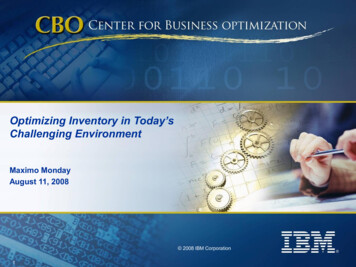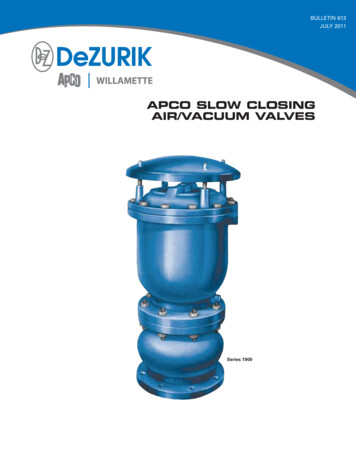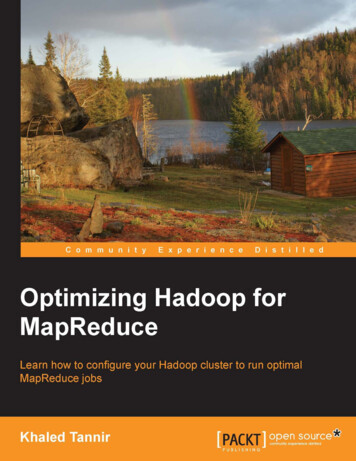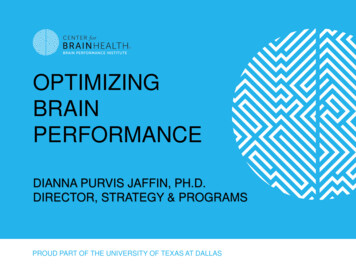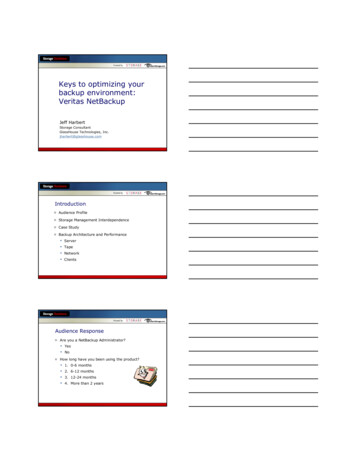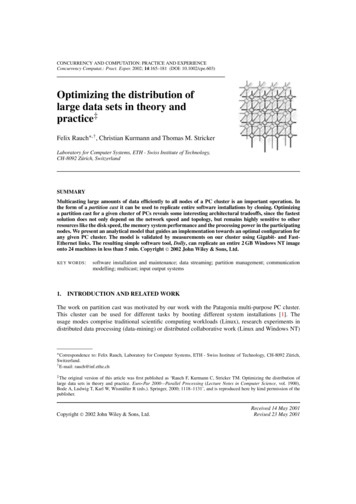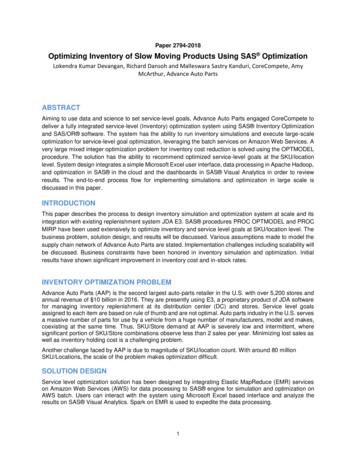
Transcription
Paper 2794-2018Optimizing Inventory of Slow Moving Products Using SAS OptimizationLokendra Kumar Devangan, Richard Dansoh and Malleswara Sastry Kanduri, CoreCompete, AmyMcArthur, Advance Auto PartsABSTRACTAiming to use data and science to set service-level goals, Advance Auto Parts engaged CoreCompete todeliver a fully integrated service-level (Inventory) optimization system using SAS Inventory Optimizationand SAS/OR software. The system has the ability to run inventory simulations and execute large-scaleoptimization for service-level goal optimization, leveraging the batch services on Amazon Web Services. Avery large mixed integer optimization problem for inventory cost reduction is solved using the OPTMODELprocedure. The solution has the ability to recommend optimized service-level goals at the SKU/locationlevel. System design integrates a simple Microsoft Excel user interface, data processing in Apache Hadoop,and optimization in SAS in the cloud and the dashboards in SAS Visual Analytics in order to reviewresults. The end-to-end process flow for implementing simulations and optimization in large scale isdiscussed in this paper.INTRODUCTIONThis paper describes the process to design inventory simulation and optimization system at scale and itsintegration with existing replenishment system JDA E3. SAS procedures PROC OPTMODEL and PROCMIRP have been used extensively to optimize inventory and service level goals at SKU/location level. Thebusiness problem, solution design, and results will be discussed. Various assumptions made to model thesupply chain network of Advance Auto Parts are stated. Implementation challenges including scalability willbe discussed. Business constraints have been honored in inventory simulation and optimization. Initialresults have shown significant improvement in inventory cost and in-stock rates.INVENTORY OPTIMIZATION PROBLEMAdvance Auto Parts (AAP) is the second largest auto-parts retailer in the U.S. with over 5,200 stores andannual revenue of 10 billion in 2016. They are presently using E3, a proprietary product of JDA softwarefor managing inventory replenishment at its distribution center (DC) and stores. Service level goalsassigned to each item are based on rule of thumb and are not optimal. Auto parts industry in the U.S. servesa massive number of parts for use by a vehicle from a huge number of manufacturers, model and makes,coexisting at the same time. Thus, SKU/Store demand at AAP is severely low and intermittent, wheresignificant portion of SKU/Store combinations observe less than 2 sales per year. Minimizing lost sales aswell as inventory holding cost is a challenging problem.Another challenge faced by AAP is due to magnitude of SKU/location count. With around 80 millionSKU/Locations, the scale of the problem makes optimization difficult.SOLUTION DESIGNService level optimization solution has been designed by integrating Elastic MapReduce (EMR) serviceson Amazon Web Services (AWS) for data processing to SAS engine for simulation and optimization onAWS batch. Users can interact with the system using Microsoft Excel based interface and analyze theresults on SAS Visual Analytics. Spark on EMR is used to expedite the data processing.1
To optimize the service level goal at distribution center (DC) and stores, two independent simulations foreach SKU/Store and SKU/DC are designed. The following assumptions are made to model supply chainnetwork for Proc MIRP simulation.1. DC inventory simulation and store inventory simulations are independent. SKU/Store simulation isalso independent of other stores.2. SKU/Stores and SKU/DC forecast is used to model SKU demand in the MIRP simulation. Variance issame as daily mean demand as Poisson distribution is assumed.3. Simulation horizon 565 days and 200 days are used as warm up period.4. Margin is difference between retail price and current unit cost.Figure 1 below explains the process flow of the system designed.Figure 1 End to end process flowINVENTORY SIMULATION: SKU/LOCATIONInventory simulation is designed to observe how will the SKU/location behave for different values of servicelevel goals considering supply chain constraints like SKU demand and variance, lead time etc.SAS procedure MIRP (Multi Echelon Inventory Replenishment Plan) has been used for designinginventory simulation model. PROC MIRP can be executed with different modeling objective values tunedto different business objective. OPTPOLICY and PREDICTKPI have been used for Advance Auto Parts.OPTPOLICY is used to generate the optimal inventory policies and PREDICTKPI is used to compute theinventory performance metrics such average inventory, fill rate etc. Any supply chain network can beorganized in the structure required in PROC MIRP and can be used to compute the inventory controlparameters and performance metrics. PROC MIRP procedures requires four datasets as input in a specifiedstructure. Descriptions of three datasets required are provided below in Table 12
DatasetsDescriptionDemandDataTakes demand and variance at customer facing SKU/locationNodeDataTakes supply chain network parameters such as lead time, PBR,batch size etc. at SKU/location.ArcDataTakes predecessor and successor information for supply chainnetwork locationsInventoryDataThis is not required when objective is OPTPOLICY. It takesinventory policy control values which are output fromOPTPOLOCY and initial value of inventory.Table 1 Input datasets to PROC MIRPData for simulation have been prepared using E3 systems, Advance Store Replenishment (ASR) andAdvance Warehouse Replenishment (AWR) for inventory replenishment at stores and DC. To simulate theAAP supply chain network, parameters values are taken from ASR, and AWR tables which are listed in theTable 2 belowSimulation ParameterSource for store simulationSource for DC simulation1Mean DemandASRAWR2VarianceASRDC order variance3Lead timeASRAWR4Periods betweenreview(PBR)ASRAWR5Batch sizeASRAWR6OrderminASRAWRTable 2 Simulation data sourcesBelow is snippet of code, used for executing MIRP procedure for SKU/location for different level of servicelevel goal. This structure is modified for running simulations for thousands of SKU/Stores and SKU/DC onthe AWS batch. Each SKU/location is simulated for 565 periods (days). Number of replication used is 2000.Proc mirp nodedata work.nodedataarcdata work.arcdatademanddata work.demanddataout temp optpolicy outputpolicyparam integerdemandmodel discretereplications 2000cv2 yesforecastinterval 1horizon 565maxcv 1objective optpolicy;run;proc sql;create table optpolicy output asselect a.networkid,a.skuloc,3
a.period,a.*,case when period 1 then initial inventory else . end as amountfrom temp optpolicy output aorder by networked,skuloc,period;quit;Proc mirp nodedata work.nodedataarcdata work.arcdatademanddata work.demanddatainventorydata optpolicy outputout predictkpi outputpolicyparam integerdemandmodel discretereplications 2000cv2 yesforecastinterval 1horizon 565maxcv 1objective predictkpi;run;Independent simulations for SKU/store and SKU/DC at different service levels (81% to 99%) for 565 periods(day) were executed and developed a library of inventory performance metrics for each unique combinationof supply chain network parameters. Inventory performance metrics are listed below1.2.3.4.5.6.7.On hand MeanBacklog MeanOrder up to levelReorder levelSafety stockFill rateReady rateOutput of PROC MIRP with objective PREDICTKPI produces above measures at period level. We dropmeasures for the first 200 periods to account for impact of initial inventory in the system and rest are usedfor computing averages at SKU/Location level. We used a conservative warm-up period since the demandis low; in 200 days, many SKUs would see a demand of only 1 unit.SERVICE LEVEL OPTIMIZATION: SKU/LOCATIONOptimization model picks the service level which minimizes the sum of holding cost and shortage cost.Parameters used in the optimization are defined belowHolding cost: Holding cost is set by the user and can vary by department, item class and vary between DCand store.Shortage cost (1-Fill Rate) x annual demand x product margin, where margin is mode of retail price minuscurrent unit cost.Indicesi: index for item4
j: index for storek: index for service level at storeq: index for DCr: index for service level at DCDecision Variablesx: binary for item-store-SL allocationy: binary for item-DC-SL allocationConstantsTotal Cost Store : Holding cost Shortage cost at storeInv store: Average inventory at storeInv cost store: Inventory cost at storeTotal Cost DC : Holding cost Shortage Cost at DCInv DC: Average inventory at DCInv cost DC: Inventory cost at DC.Objective:Minimize: Total Cost (Holding Cost Shortage Cost) across all SKU-Stores and SKU-DCs (𝑥𝑖𝑗𝑘 Total Cost Store 𝑖𝑗𝑘 ) (𝑦𝑖𝑞𝑟 Total Cost DC 𝑖𝑞𝑟 )𝑖𝑖𝑘𝑖𝑞𝑟Decision:For each SKU-Store and SKU-DC, pick a ready rate. This is binary as only one Ready Rate can be picked.Thus, the number of binary variables will be equal to the sum of the number of ready-rate records acrossall SKU-Stores and SKU-DCs. We have defined two categories of binary decision variable 1. Store-SKUbinary and DC-SKU binary. Hence decision variables𝑥𝑖𝑗𝑘 and 𝑦𝑖𝑞𝑟 are binary variablesConstraints:Set 1: Store-SKU and DC-SKU can have only one Service Level. Pick only one ready rate. (ensures onlyone ready rate is selected for a SKU-Store or SKU-DCFor each SKU-store, sum of binaries 1 (𝑥𝑖𝑗𝑘 ) 1 𝑓𝑜𝑟 𝑖, 𝑗𝑘For each SKU-DC, sum of binaries 1 (𝑦𝑖𝑞𝑟 ) 1 𝑓𝑜𝑟 𝑖, 𝑞𝑟When there is no budget constraint model recommends optimum service level without taking account ofallocated budget. Note that since we are balancing holding cost and Shortage Cost, optimization will notpick the ready rate of 99% unless justified; the max ready rate might be incurring very high holding cost andnot giving us enough reduction in Shortage Cost.Set 2: Budget for inventory is limitedFor all SKU-Locations and their ready rates, total cost of inventory cannot exceed budgetInventory cost for SKU/Locations will be average inventory at given Ready Rate X Unit cost of the SKU 𝑥𝑖𝑗𝑘 Inv store𝑖𝑗𝑘 Inv cost store𝑖𝑗𝑘 𝑥𝑖𝑗𝑘 Inv DC𝑖𝑗𝑘 Inv cost DC𝑖𝑗𝑘𝑖𝑖𝑘𝑖𝑖𝑘 𝐵𝑢𝑑𝑔𝑒𝑡PROC OPTMODEL is used to model the above optimization problem which is executed on AWS cloudusing batch services.TECHNICAL CHALLENGES AND RESOLUTIONS5
Advance Auto Parts manages tens of millions, SKU/locations. Number of unique SKU covered in this projectexceeded 100,000 with thousands of stores. Running PROC MIRP simulation honoring businessconstraints such as batch size, minimum order and min max inventory policy is highly time-consumingprocess. MIRP simulation of an independent SKU/location for 15 distinct service level values takes on anaverage 7 seconds for 2,000 replications and 565 periods on r4.4xlarge having 16 vCPU and 122GB RAM.If number of replication is reduced to 500 it takes 3.5 seconds but at the cost of accuracy. By going withthis estimate, it will take years to run independent simulations for millions of SKU/locations.SCALING OUT SIMULATION AND OPTIMIZATION ON AWSSolution library and elastic processing on AWS are used to resolve run time challenges. To deal with timeconsuming exercise of simulation and optimization, PROC MIRP and PROC OPTMODEL are deployedand executed as AWS Batch jobs. Apache Hadoop was used for reducing the taken in data preparationand output summarization. The end to end approach used for simulation and optimization is discussedbelow.Run simulation for unique set of supply chain parameters. If 10 SKU/stores have same parameters (leadtime, PBR, Mean demand, Variance etc.), run simulations only once for one SKU/store and store inventoryperformance metrics in a permanent solution library. This reduces number of simulations requiredsignificantly close to 2,000,000 from 80 million but still simulation cannot be completed within hours.Deploy PROC MIRP on AWS Batch services to run simulations in parallel in thousands of machines atcheap cost for SKU/location not having match in the solution library. Candidate SKU/locations with uniqueparameters can be divided into multiple batch job tables. AWS Batch services forms a queue of jobs andallocates a machine to each job. Machines use preconfigured docker image registered in AWS repositoryto create required SAS environment. Data and SAS program required for the simulation is exportedusing a shell script.Inventory Optimization is scaled out using EMR for initial data processing and post optimization dataprocessing for each department. PROC OPTMODEL is deployed on AWS batch services to run Noptimization for N departments. TheFigure2belowdepictsarchitectureforscalingFigure 2 architecture to scale out on
BUSINESS CHALLENGES AND RESOLUTIONSBusiness users wants to test multiple scenarios with different assumptions on cost and lost sales. An OnDemand Inventory Optimization tool is developed which can be used to launch optimization for selecteddepartments. Users can run test scenarios using this tool. Microsoft Excel is used for developing userinterface and optimization results are shown on SAS Visual Analytics (VA) platform.ON DEMAND OPTIMIZATION TOOL: USER INTERFACEMicrosoft Excel based custom user interface enables user to modify carrying cost and lost salesassumptions and analyze the scenario results. Business users can use this custom interface for running ondemand optimization for multiple departments on AWS. Users can kick-off optimization with different valuesof cost and constraint parameters. VBA program is used to capture the input information which is passedinto SAS server on Unix platform using Putty. VBA program triggers shell script which eventually triggersSAS program. AWS EMRs have been used for ETL process and are smoothly integrated withSAS engine. SAS Visual Analytics is used to display the results. Display 1 shows the interfacedeveloped using MS Excel.Display 1 User interface to launch test optimization scenariosDASHBOARD ON SAS VISUAL ANALYTICSSAS Visual Analytics (VA) is used to display the results obtained by the optimization. Reports havecapability to compare the multiple scenarios. There are sections to report monetary impacts on stores andDC separately. The cost parameters entered by the user in On Demand Microsoft Excel tool is also madeavailable in SAS VA.CONCLUSIONBy storing MIRP results, significant computation costs and time can be reduced by creating a library ofexpected supply chain results at various service levels. Using a containerized approach to parallelizingSAS in docker images allows Advance Auto Parts to utilize the advantage of elastic computing offered bythe cloud to run inventory optimization on a very large supply chain.7
The optimization capability allows Advance Auto Parts to allocate constrained budget resources optimallybased on the margin, demand velocity and supply chain structure of every store location to maximizeexpected return from limited inventory investment dollars.The service level recommendations are highly sensitive to shortage and holding cost. The interfacedeveloped allows planners to apply judgement and analytical insights from other teams to adjust the holdingand shortage costs used in the optimization. This allows the system to reflect substitutability in demandthrough lower shortage costs, as well as the very different holding costs associated with store vs. DC, highcube items vs smaller items and other scenarios.PROC MIRP can be used for developing simulation model for a complex supply chain network. For largenetwork PROC MIRP takes longer time compared to smaller networks. Also, number of replication playssignificant role in accuracy as well as in time complexities. These challenges can be handled easily bymoving the simulation and optimization on AWS batch which scales out at low cost.REFERENCESSAS Institute Inc. 2014. SAS Inventory Replenishment Planning 2.3: User’s Guide. Cary, NC: SAS InstituteInc.SAS Institute Inc. 2011. SAS/OR 9.3 User’s Guide: Mathematical Programming. Cary, NC: SAS InstituteInc.ACKNOWLEDGMENTSSpecial thanks to Dr. Ajay Mishra, CoreCompete and Dr. Christopher Houck, CoreCompete for theguidance during the design and development of scalable inventory optimization system. Also, thanks toJason Blane, Advance Auto Parts and Mark O'Connell, Advance Auto Parts for providing business insightsand understanding to develop the solution.CONTACT INFORMATIONYour comments and questions are valued and encouraged. Contact the author at:Lokendra Kumar DevanganCoreCompeteE-mail: omSAS and all other SAS Institute Inc. product or service names are registered trademarks or trademarks of SASInstitute Inc. in the USA and other countries. indicates USA registration.Other brand and product names are trademarks of their respective companies.8
network for Proc MIRP simulation. 1. DC inventory simulation and store inventory simulations are independent. SKU/Store simulation is also independent of other stores. 2. SKU/Stores and SKU/DC forecast is used to model SKU demand in the MIRP simulation. Variance is same as daily mean demand as Poisson distribution is assumed. 3.
